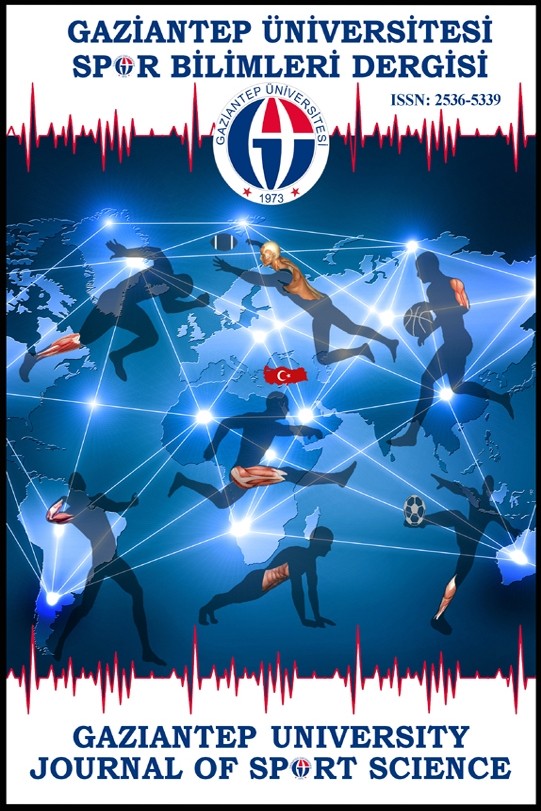Effect of Different Pre-Competition Anxiety and Self-Confidence on the Performance in Bouldering Climbers
Bu çalışma kısa kaya tırmanıcılarında yarışma öncesi farklı kaygı türleri ve özgüvenin performans üzerine etkisini değerlendirmek amacıyla planlandı. Çalışmaya 18-31 yaş arasındaki 41 kısa kaya tırmanış sporcusu (18 kadın, 23 erkek) dahil edildi. Sporcuların demografik bilgileri alındıktan sonra, yarışma öncesi kaygı durumu Yarışmasal Durumluluk Kaygı Ölçeği (CSAI) ve Durumluluk Sürekli Kaygı Ölçeği (STAI) ölçeği ile değerlendirildi. CSAI’ nın bilişsel kaygı, somatik kaygı ve kendine güven olmak üzere 3 alt parametre değerlendirilirken, STAI ile durumluk kaygı ve sürekli kaygı olmak üzere 2 ayrı parametre değerlendirildi. Yarışma sonrası sporcuların performans puanları kaydedildi. Yarışma öncesi farklı kaygı türleri ile performans arasındaki ilişki incelendiğinde, durumluk kaygı ile performans arasında negatif yönlü orta şiddetli korelasyon bulundu (p:0.000, r:-590). Kadın ve erkek sporcular kaygı düzeyleri bakımından karşılaştırıldığında aralarında anlamlı bir farklılık bulunamazken (p>0.05), performans puanları bakımından karşılaştırıldığında aralarında anlamlı bir farklılık bulundu (p<0.05). STAI ile CSAI ölçeklerinin her biri kendi parametreleri içinde korelasyon olduğu tespit edildi. Kısa kaya tırmanıcılarında yarışma öncesi durumluk kaygı düzeyinin sportif performansı olumsuz etkileyebileceği belirlendi. Kadın ve erkek sporcular benzer kaygı düzeyine sahip olmasına rağmen kadın sporcuların yarışma performansının daha düşük olduğu saptandı.
Anahtar Kelimeler:
kaygı, tırmanış, performans, spor
Effect of Different Pre-Competition Anxiety and Self-Confidence on the Performance in Bouldering Climbers.
This study was planned to evaluate the effect of different pre-competition anxiety types and self-confidence on performance in bouldering climbers. Forty-one bouldering climber (18 women, 23 men) at ages 18-31 years were included in the study. After receiving the demographic information of the athletes, the pre-competition anxiety scores was assessed by the Competitive State Anxiety Scale (CSAI) and State Trait Anxiety Scale (STAI). CSAI's three sub-parameters were cognitive anxiety, somatic anxiety and self-confidence. Two different parameters were evaluated with STAI, state anxiety and trait anxiety. Performance scores of the athletes after the competition were recorded. When the relationship between different pre-competition anxiety types and performance was examined, there was negative moderate correlation between state anxiety and performance (p: 0.000, r: -590). While there was no significant difference between male and female athletes in terms of pre-competition anxiety levels (p>0.05), there was a significant difference between them in terms of performance scores (p<0.05). It was determined that the STAI and CSAI scales each had correlation within own parameters. The level of state anxiety before the competition in bouldering climbers could negatively affect sportive performance. Although the male and female athletes have similar level of pre- competition anxiety, the performance of female athletes was found to be lower.
Keywords:
anxiety, bouldering, performance, sports,
___
- Aşçi F.H., Koca C., Demirhan G., Dinç S.C. (2006). Precompetitive anxiety and affective state of climbers in indoor climbing competition. Perceptual and motor skills. 102(2): 395-404.
- Canan F., Ataoğlu A. (2010). Anksiyete, depresyon ve problem çözme becerisi algısı üzerine düzenli sporun etkisi. Anatolian Journal of Psychiatry. 11(38): 38-43.
- Coelho E.M., Vasconcelos-Raposo J., Fernandes H.M. (2007). Confirmatory factor analysis of the Portuguese version of the CSAI-2. Motricidade. 3(3): 73-82.
- Craft L.L., Magyar T.M., Becker B.J., Feltz D.L. (2003). The relationship between the Competitive State Anxiety Inventory-2 and sport performance: A meta-analysis. Journal of sport and exercise psychology. 25(1): 44-65.
- Ferrand C., Tetard S., Fontayne P. (2006). Self-handicapping in rock climbing: A qualitative approach. Journal of Applied Sport Psychology. 18(3): 271-280.
- Gould D., Petlichkoff L., & Weinberg R.S. (1984). Antecedents of, temporal changes in, and relationships between CSAI-2 subcomponents. Journal of Sport Psychology. 6(3): 289-304.
- Hagtvet K.A., Hanin Y. L. (2007). Consistency of performance-related emotions in elite athletes: Generalizability theory applied to the IZOF model. Psychology of sport and exercise. 8(1): 47-72.
- Judge L.W., Urbina L.J., Hoover D.L., Craig B.W., Judge L.M., Leitzelar, B.M., Bellar D.M. (2016). The Impact of Competitive Trait Anxiety on Collegiate Powerlifting Performance. The Journal of Strength & Conditioning Research. 30(9): 2399-2405.
- Koruç Z. (1998). CSAI-2’nin Türkçe uyarlaması. V. Spor Bilimleri Kongresi. Ankara: Hacettepe Üniversitesi, 93.
- Martens R., Vealey R.S., Burton D. (1990). Competitive anxiety in sport: Human kinetics.
- Nassib S.H., Mkaouer B., Riahi S.H., Wali S.M., Nassib S. (2017). The precompetitive anxiety impacts immediately actual gymnastics’ performance or sustain during routine’s outcomes over the execution time. Sport Sciences for Health. 13(1): 165-173.
- Öner N., & LeCompte W.A. (1985). Durumluk-sürekli kaygı envanteri el kitabı: Boğaziçi Üniversitesi Yayınları.
- Radochoński M., Cynarski W., Perenc L., Siorek-Maślanka L. (2011). Competitive anxiety and coping strategies in young martial arts and track and field athletes. Journal of Human Kinetics. 27: 180-189.
- Sedarati M. (2007). Anxiety of female students competing in the championship. J Women Stu. 2(5): 120-127.
- Szabo A., Szűcs A., Gáspár Z., Süle K. (2014). Anxiety and affect in successful and less successful elite female basketball players: in-situ sampling before six consecutive games. LASE Journal of Sport Science. 5(2): 76-91.
- Zamani A., Moradi A. (2009). Compare trait anxiety, state anxiety and confidence men athletes in individual sports and team sports. J Knowl Res in Appl Psych. 11(40): 63-72.
- ISSN: 2536-5339
- Başlangıç: 2016
- Yayıncı: Gaziantep Üniversitesi
Sayıdaki Diğer Makaleler
Zilan BAZANCİR, Muharrem Gökhan BEYDAĞI, Burcu TALU
Kadınlarda 8 Haftalık Pilates Programının Kan Lipidleri Üzerine Etkileri
Hacı Bayram TEMUR, Muzaffer SELÇUK, Vedat ÇINAR, Merve ÖZTÜRKER, Mücahit SARİKAYA
Amerika Basketbol Ligi (NBA) Maç Sonuçlarının Yapay Sinir Ağları ile Tahmini
